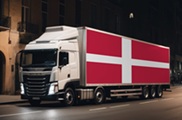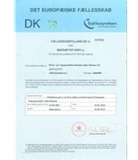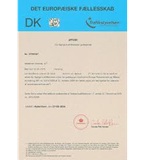Comprehensive Guide to Starting a Transport Company in Denmark
 Denmark’s strategic location in northern Europe, advanced infrastructure, and thriving economy make it an ideal base for transport businesses. Whether you plan to operate within Denmark or across Europe, launching a transport company requires compliance with national and EU regulations, careful planning, and an understanding of Denmark’s business environment. This article provides a detailed guide to help you successfully start and manage a transport company in Denmark.
Denmark’s strategic location in northern Europe, advanced infrastructure, and thriving economy make it an ideal base for transport businesses. Whether you plan to operate within Denmark or across Europe, launching a transport company requires compliance with national and EU regulations, careful planning, and an understanding of Denmark’s business environment. This article provides a detailed guide to help you successfully start and manage a transport company in Denmark.
Business Registration: Choosing a Legal Form
The type of legal entity you choose will determine your business’s tax obligations, liabilities, and management structure. In Denmark, common options include:
- Sole Proprietorship (Enkeltmandsvirksomhed):
- Easy to set up but involves unlimited personal liability. Enkeltmandsvirksomhed
- Private Limited Company (Anpartsselskab - ApS):
- Requires a minimum share capital of DKK 40,000 and offers limited liability. Anpartsselskab (ApS)
- Public Limited Company (Aktieselskab - A/S):
- Designed for large enterprises, requiring a share capital of DKK 400,000 Aktieselskab (A/S)
- Partnership (Interessentskab - I/S):
- Suitable for businesses with multiple owners, with shared liability. Interessentskab (I/S)
Business Registration Process
- Register with the Danish Business Authority (Erhvervsstyrelsen):
-
 Register your company through the Virk.dk online platform. Obtain a CVR number, the unique identification for your business. Registrer din virksomhed, og få et CVR-nummer.
Register your company through the Virk.dk online platform. Obtain a CVR number, the unique identification for your business. Registrer din virksomhed, og få et CVR-nummer.
- Tax Registration:
-
 Register for VAT (Moms), mandatory for businesses with annual revenues exceeding DKK 50,000. Sådan registrerer du din virksomhed for moms - SKAT
Register for VAT (Moms), mandatory for businesses with annual revenues exceeding DKK 50,000. Sådan registrerer du din virksomhed for moms - SKAT
- Employer Registration:
-
 If hiring employees, register with the Danish Customs and Tax Administration (SKAT) and ATP Livslang Pension, Denmark’s labor market pension fund. ATP Livslang Pension til dine medarbejdere
If hiring employees, register with the Danish Customs and Tax Administration (SKAT) and ATP Livslang Pension, Denmark’s labor market pension fund. ATP Livslang Pension til dine medarbejdere
Licensing and Permits: Transport Licenses
 To operate a transport company in Denmark, you must obtain the appropriate licenses:
To operate a transport company in Denmark, you must obtain the appropriate licenses:
- National Transport License:
- For companies operating only within Denmark.
- EU Community License:
- Required for cross-border transport within the EU. Sådan opnår du fællesskabstilladelse til godskørsel
Licensing Conditions

- Certificate of Professional Competence (CPC):
- The transport manager must hold a CPC, demonstrating knowledge of transport regulations and operations. Kvalifikationsuddannelsen
- Financial Capacity:
- Prove sufficient funds to operate: €9,000 for the first vehicle and €5,000 for each additional vehicle.
- Good Repute:
- Provide evidence of a clean criminal record and financial integrity for the company’s key personnel.
Special Permits
- ADR Certification:
- Required for the transportation of hazardous goods. Farligt gods uddannelse
- Oversized Load Permits:
- Necessary for transporting large or heavy cargo.
Vehicle Registration and Compliance
- Vehicle Registration
-
 All commercial vehicles must be registered with the Danish Motor Vehicle Registry (Motorregistret). Requirements include: Proof of vehicle ownership or leasing agreements. Vehicle insurance documentation. Vehicle inspection certificates. Køretøj Registrering og omregistrering
All commercial vehicles must be registered with the Danish Motor Vehicle Registry (Motorregistret). Requirements include: Proof of vehicle ownership or leasing agreements. Vehicle insurance documentation. Vehicle inspection certificates. Køretøj Registrering og omregistrering
- Technical Inspections
- Commercial vehicles must undergo regular inspections to ensure roadworthiness. Ensure compliance with EU emissions standards, including Euro 6 norms. Alle biler skal have regelmæssige serviceeftersyn
Insurance Requirements
- Mandatory Insurance
- Motor Liability Insurance: Covers damages caused to third parties by company vehicles. Cargo Insurance: Protects goods against loss, theft, or damage during transit. Employee Insurance: Covers workplace injuries if you employ staff.
- Optional Insurance
- Comprehensive Vehicle Insurance: Provides additional protection for company vehicles. Business Liability Insurance: Safeguards against operational risks.
Employment and Labor Regulations
- Hiring Drivers
- Drivers must have a valid Category C or CE driver’s license for heavy goods vehicles. Completion of Driver Certificate of Professional Competence (CPC) training is mandatory. EU bevis Lastbil m. Køreteknik
- Labor Compliance
- Danish labor laws ensure fair wages, working conditions, and benefits. Sign contracts in line with Danish employment standards and collective agreements.
- Driving Hours and Rest Periods
- Adhere to EU Regulation (EC) No 561/2006, which governs driving hours and rest breaks. Equip vehicles with tachographs to monitor compliance. Køretid og hvileperioder i vejtransportsektoren
Taxation and Financial Obligations
- Corporate Taxes
- Corporate tax in Denmark is 22%, with various deductions available for business expenses. Businesses must charge and pay VAT (Moms), typically 25%, on most goods and services.
- Vehicle Taxes and Road Tolls
- Heavy Goods Vehicles (HGVs) are subject to weight-based taxes. Pay tolls on certain highways and bridges, such as the Øresund Bridge, using electronic toll systems.
Environmental and Sustainability Standards
- Low-Emission Zones (LEZs):
- Major cities, including Copenhagen, enforce LEZs, restricting access for older, high-polluting vehicles. Miljøzoner i Danmark
- Incentives for Green Vehicles
- Denmark offers subsidies for adopting electric or hybrid vehicles and investing in eco-friendly technologies. Businesses can benefit from tax deductions for using sustainable fuel sources.
Operational Standards and Safety
- Cargo Safety
- Adhere to EU standards for securing cargo during transport. Equip vehicles with safety gear, such as reflective signs, fire extinguishers, and first aid kits.
- Workplace Safety
- Implement regular training programs for employees on safety protocols and efficient loading/unloading practices.
- Record Keeping
- Maintain detailed records of vehicle maintenance, driver hours, and operational activities to ensure compliance with inspections.
Inspections and Penalties
- Regulatory Inspections
- Danish authorities conduct regular inspections to ensure compliance with transport laws and safety standards.
- Penalties for Non-Compliance
- Violations, such as overloading or non-compliance with driving hours, can result in fines, license suspensions, or legal action.
Conclusion
Starting a transport company in Denmark offers immense potential in a thriving and sustainable logistics market. By adhering to Danish and EU regulations, securing the right licenses, and leveraging modern tools, you can establish a successful and competitive transport business. Strategic planning and a commitment to environmental standards will ensure long-term growth in this dynamic industry.
eXus Dev